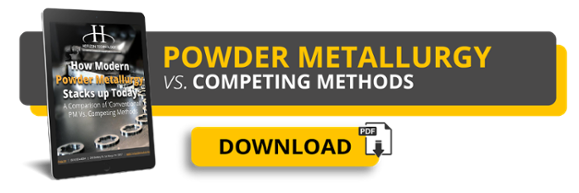If you’ve paid any attention to the “Part of the Year” awards in powder metallurgy circles, you’ve probably noticed that metal injection molding (MIM) parts are popular among critics. You may have also heard the praises of MIM parts over conventional powder metallurgy (PM) from potential suppliers.
With all the hype, it’s easy to assume that MIM is the future. But there is more to the story. While MIM is excellent for niche applications, conventional powder metallurgy still offers numerous benefits for a wide variety of small parts manufacturing projects.
Read on to learn more about metal injection molding vs. powder metallurgy.
Metal Injection Molding vs. Powder Metallurgy: What’s the Difference?
It helps to know how metal injection molding and conventional powder metallurgy are related when you’re deciding which process suits your needs. Let’s look at conventional PM first, since it’s been around for a lot longer.
Powder Metallurgy Basics
- Begin with blending or mixing specific types of metal powders and lubricants.
- Place the mix in a die to create a certain shape.
- Use a press to compact the metal powder tightly.
- Sinter the compressed part in a furnace to form metallurgical bonds in the metal powder.
The mass manufacturing of powder metal parts has been going on for well over 100 years. It’s used to make a wide variety of parts of different shapes and sizes, ideal for a host of automotive and other applications.
Metal Injection Molding Basics:
- Blend metal powders with polymer binders to create a viscous solution
- Inject the solution into a molding machine (Think of toothpaste filled with metal powder that’s injected into the die cavity.)
- Apply heat to remove the binder
- Sinter at high temperatures to form metallurgical bonds and densify the powder
Comparatively speaking, MIM is a fairly new process. It has only become more widely used in the last couple decades, and MIM manufacturing costs are still quite high. We’ll tell you how high in a bit.
Primer for Choosing Between Conventional PM and MIM
There are a lot of similarities between metal injection molding and conventional powder metallurgy. At the same time, there are a few drastic differences that make one process preferable over the other depending on the circumstances.
1. MIM is excellent for complex shapes.
MIM is awesome for making parts that can benefit from an intricate design. The ability to create an essentially liquid feedstock and injection mold it means you can design molds with more complexity than you could with dies taking metal powders.
Conventional powder metallurgy is still a better option for complex shape making than many other competing process, though.
2. MIM requires high temperatures to sinter.
One of the big downsides to MIM parts is the heat requirements for sintering. Heating these parts to sinter them can add substantial cost to the manufacturing process.
3. MIM parts go through approximately 25% shrinkage.
A large part of the volume of MIM feedstock is made up of binders -- much of which needs to be removed during sintering. That means you lose around 25%, which can eat into your materials budget as you require more powder to compensate for shrinkage.
4. MIM is expensive.
You can make some impressive parts with MIM -- the kind that will win you fancy awards. But there is a huge tradeoff in cost.
While premixed, press-ready conventional powder for die compaction might run you $1-$2 a pound, the feedstock for a MIM part typically costs $10-$12 a pound -- or even higher. High sintering temperature requirement is only one of the factors that contribute to high per-part costs.
With many parts, even if you need additional machining operations, conventional powder metallurgy is often a higher-value option.
5. You really have to look closely at cost versus performance.
Since metal injection molding manufacturing costs far more than conventional powder metallurgy, you have to look closely at your specific performance needs.
The parts you get through MIM can be more complex and will require a bit less machining. But are the benefits of complexity and avoiding machining worth the price tag? Remember that many conventional PM projects can produce net shape parts, too.
6. Your parts need to be small.
Generally speaking, there are major size limitations on what can be done.
Can you accomplish your manufacturing goals while being limited to ¼-in. part size?
Getting the Most Out of Your Parts Manufacturer
You know how important it is to stay on budget -- that’s probably what brought you to powder metal in the first place.
This often means passing on the coolest, sexiest processes for something more economical and tried-and-true. (Yes, we’re even looking at you too, 3D printing.) With continued education and development of technology, there’s no reason to think “old-fashioned” powder metallurgy won’t be part of the wave of the future in electric vehicles and many other industries.



